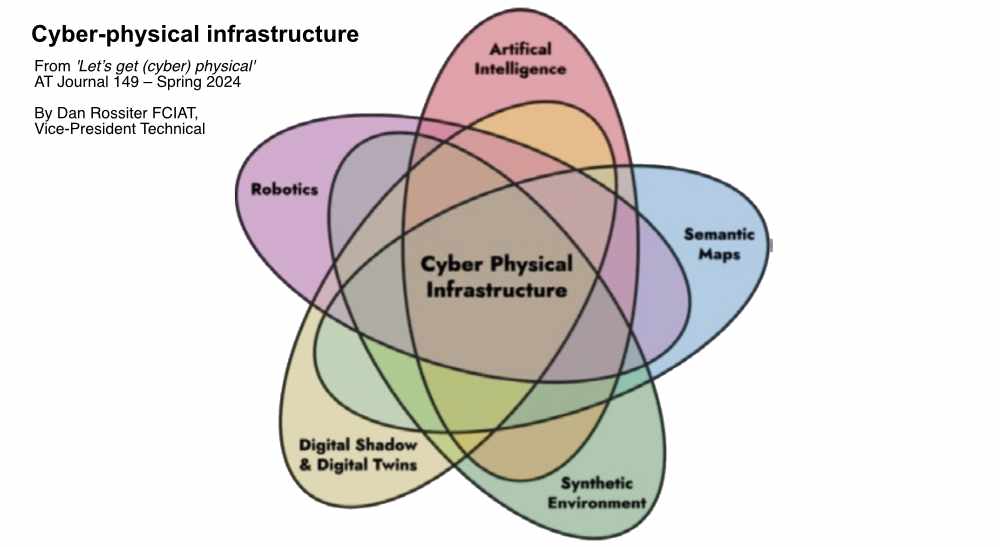Getting cyber-physical
Contents |
[edit] What has been going on?
Back in 2022, the Department for Science, Innovation, and Technology (DSIT) alongside the Department for Business and Trade (DBT) published a consultation on the Government’s vision for enabling cyber-physical infrastructure. A new term for many, cyber-physical infrastructure encapsulates concepts which connect the physical and digital domain; such as digital twins, internet of things, artificial intelligence and robotics. See cool diagram above.
Following a wealth of input, a consultation response document was published outlining several key enablers to realise a society empowered by cyber physical infrastructure, these being:
- Security and resilience: in particular how to overcome risk aversion and enable trust as part of data-driven decision making;
- Interoperability: in the wider sense, including interoperability of expectations and ethics;
- Recognised value proposition: considering that a significant proportion of potential value lies in interconnection between datasets;
- Frameworks, guidance and standardisation: fundamental enablers and catalysts for adoption; and
- Skills: ensuring society has the capability to establish, maintain and utilize such infrastructure.
The report also helpfully includes case studies which cut across key sectors such as energy, transport and the built environment. Among these case studies is work undertaken by the various catapults, this work is also helpfully summarised by Simon Hart on the UKRI website. In further support of realising cyber-physical infrastructure, Innovate UK also commissioned Responsive Infrastructure (The Fenby-Taylor Review). Henry, the author, has written about this report in more detail elsewhere. However, I thought it was worth highlight several of its recommendations below, including:
- Increasing the visibility and viability of innovators;
- addressing the skills gap;
- more tailored access to relevant research; and
- creating the opportunity to develop and test ideas within safe environments.
Finally, the several catapults have joined forces to explore how to best establish a cyber-physical system innovation ecosystem.
[edit] How can I engage?
Clearly there are a plethora of activities underway. So, what are some of the best ways to engage with this work?
[edit] National cyber-physical infrastructure
If you are interested in the work being undertaken by the catapults to realise an innovation ecosystem, it is probably best to read Responsive Infrastructure (The Fenby-Taylor Review) and join the Digital Twin Hub. Several updates relating to NCPI have already appeared on the Hub.
[edit] Digital Twins
again, an ideal place to engage would be the Digital Twin Hub. If you are interested in the National Digital Twin programme specifically, they have recently created their own NDTp gov.uk site, which is currently populated with case studies. Alternatively, if you are of a more disruptive mindset, you may enjoy engaging with the Digital Twin Fan Club and their podcast series. Finally, keep an eye out on the BSI website for the upcoming publication of BS ISO 30172 (digital twin use case) and BS ISO 30173 (digital twin concepts and terminology).
[edit] Information Management and BIM
a foundational concept, information management and BIM continues to gain momentum both nationally and globally. One of the best ways to engage with the topic is through Nima as well as the UK BIM Framework website.
[edit] Artificial Intelligence
if you are interested in standards (who is not?), then Alan Turing’s AI Standards Hub, is an ideal forum for you to engage with as well as our national standards committee for artificial intelligence ART/1. Alternatively, if you are an innovator, in particular a small business, you may be interested in the Innovate UK BridgeAI programme which offers funding and support to help innovators assess and implement AI.
Whilst digital has been gaining momentum since the advent of computers, it had been doing so in a disjointed manner. The introduction of cyber-physical infrastructure has, helpfully, begun to bring these concepts under a single holistic framework. I am hopeful that this will not only catalyse our journey to a more digital built environment, but also reduce frictions as we explore innovations beyond BIM.
This article appears in the AT Journal issue 149, Spring 2024 as "From 'Let’s get (cyber) physical' " written by Dan Rossiter FCIAT, Vice-President Technical.
--CIAT
[edit] Related articles on Designing Buildings
- CIAT articles.
- Cyber hygiene
- Cyber-physical system.
- Cyber resilience
- Cyber security
- Cyber security and engineering
- Cyber-security and phishing
- Cyber security specialist
- Cyber threats to building automation and control systems
- ECA cyber security policy template
- Infrastructure and cyber attacks
- Mitigating online risk with Cyber Essentials security
- National Cyber Security Centre
- UK organisations encouraged to review cyber security in response to situation in and around Ukraine
Featured articles and news
Gregor Harvie argues that AI is state-sanctioned theft of IP.
Experimental AI housing target help for councils
Experimental AI could help councils meet housing targets by digitising records.
New-style degrees set for reformed ARB accreditation
Following the ARB Tomorrow's Architects competency outcomes for Architects.
BSRIA Occupant Wellbeing survey BOW
Occupant satisfaction and wellbeing tool inc. physical environment, indoor facilities, functionality and accessibility.
Preserving, waterproofing and decorating buildings.
Many resources for visitors aswell as new features for members.
Using technology to empower communities
The Community data platform; capturing the DNA of a place and fostering participation, for better design.
Heat pump and wind turbine sound calculations for PDRs
MCS publish updated sound calculation standards for permitted development installations.
Homes England creates largest housing-led site in the North
Successful, 34 hectare land acquisition with the residential allocation now completed.
Scottish apprenticeship training proposals
General support although better accountability and transparency is sought.
The history of building regulations
A story of belated action in response to crisis.
Moisture, fire safety and emerging trends in living walls
How wet is your wall?
Current policy explained and newly published consultation by the UK and Welsh Governments.
British architecture 1919–39. Book review.
Conservation of listed prefabs in Moseley.
Energy industry calls for urgent reform.
Heritage staff wellbeing at work survey.

























